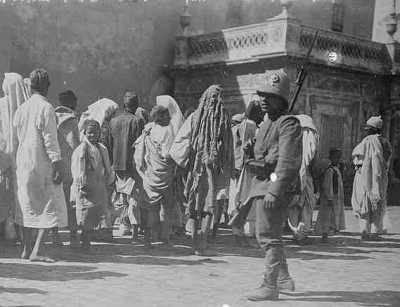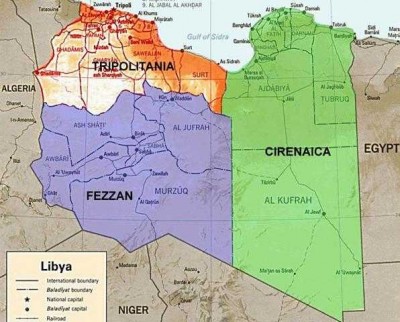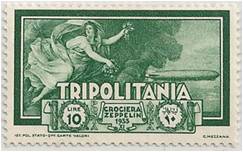ALBUM – view my Tripolitania album
TRANSITION CHART – Libya Area
Fast Facts
Region: North Africa
Group: Libya Area
Classification: Italian Colonies
Prior Regime: Tripolitanian Republic
Key Dates:
1911 – Tripolitania was captured from the Ottomans by Italy
1912, Oct 18 – Libya, including Tripolitania was ceded to Italy by the Ottoman Empire
1918 – The Arab Tripolitanian Republic declared
1922, Nov 12 – Tripolitania annexed by Italy
1923 – Tripolitanian Republic dissolved
1934, Jan 1 – Tripolitania, Cyrenaica, and Fezzan joined to form the Italian colony of Libya.
Following Regime: Italian Colony of Libya
Scott Catalogue: (Tripolitania) 1-78, B1-B58, C1-C48, CB1-CB10, CBO1, CE1-CE2, EY1
Pick Catalogue: none
History

The Italians slowly advanced capturing parts of the Ottoman provinces of Tripolitania, Fezzan and Cyrenaica, in addition to the Dodecanese Islands in the Aegean Sea. However, by the autumn of 1912, as the first Balkan war broke in Europe, the Ottomans were forced to withdraw troops to the Balkan front, conceding defeat in the region. The Turks signed the Treaty of Ouchy on 12 Oct, 1912 ceding the Provinces of Tripolitania and Cyrenaica to Italy, and continued to allow Italian administration of the Dodecanese Islands. Turkey eventually renounced all claims on these islands in 1923.
As World War I broke out in 1914, Italian troops were withdrawn from the region, with the exception of the coastal towns. Control of the inland territory reverted back to the local Senussi zawiya (fortified outposts around a mosque). After the war, the local population in Tripolitania, declared the formation of an Arab Republic called the “Tripolitanian Republic” on 16 Nov, 1918. The declaration was formally presented during the 1919 Paris Peace Conference, but gained little support from international powers. The fledging republic eventually dissolved in 1923, as the Italians began to establish firm control over the region, creating two separate colonies of Tripolitania and Cyrenaica.
As Mussolini and the Fascists seized control of the Italian Government (October 1922), they officially annexed Tripolitania in Nov, 1922 and began to rule the colony with an “iron fist”, including the use of concentration camps to quell local resistance. While Italian forces continued to encounter strong resistance in Cyrenaica, they were quite successful in Tripolitania.
Colonial rule in Tripolitania was primarily a military rule. Mussolini often called the Libyans “Muslim Italians,” however Italian investment in Libya was made primarily to extract resources or to promote settlement of Italians to Libya. No development effort was used to better the local Arab population such as education or modernization. Over time, Italian troops continued to advance south, assuming control in Fezzan, although it remained a “Military Territory”.
On 1 Jan, 1934, the colonies of Tripolitania and Cyrenaica along with the Military Territory of Fezzan were combined to form the single Italian Colony of Libya. The colony lasted until World War 2, when British troops eventually drove all Italian and German forces out of Libya completely in Feb, 1943.
Stamps
 ALBUM
ALBUM
Throughout the period of the individual colonies, Tripolitania and Cyrenaica issued separate commemorative, air post and authorized delivery stamps. However definitive, parcel post, postage due and express stamps were combined and issued under the name of “Libia”.
The first stamps for Tripolitania, were issued on 24 Oct, 1923, by overprinting the 4 stamps in the Italian “Propaganda for the Faith” series with “TRIPOLITINIA” in black. Many Italian commemorative series continued to be overprinted “Tripolitania” in various colors and fonts for the entire existence of the colony. These include:
“Propaganda for the Faith” Series – 1923, Oct 24
“Fascisti” or “March on Rome” Series – issued 1923, Oct 29
“Manzoni” Series – issued 1924, Apr 1
“Victor Emmanuel” Series – issued 1925 – 1926
“Saint Francis of Assisi” Series – issued 1926, Apr 12
“Volta” Series – issued 1927, Oct 10
“Monte Cassino” Series – issued 1929, Oct 14
“Royal Wedding” Series – issued 1930, Mar 17
“Ferrucci” Series including air post – issued 1930, Jul 26
“Virgil” Series including air post – issued 1930, Dec 4
“St. Anthony of Padua” Series – issued 1931, May 2
“Holy Year” Series – issued 1925
“Charitable work of the Voluntary Militia for Italian National Defense” Series – issued 1927, Apr 21, 1929, Mar 4, 1930, Oct 20
Additionally, the Italians overprinted Italian air post semi-postal, air post semi-postal official, air post semi-postal special delivery and authorized delivery stamps.
Note that Scott #’s normally denotes a semi-postal stamp (those with an extra surtax beyond postage) with the prefix “B”. However, since many series of Italy and the Italian Colonies stamps include one or more semi-postal stamps, these issues are generally listed as regular postage, airmail stamps unless all the stamps in the series carry the surtax.
Additionally, series of stamps were specially printed for use in Tripolitania, including a Colonial Institute Issue (featuring a common design from the colonies) issued on Jun 1, 1926, several Air Post series, and two special flight issues.
Lastly, two beautiful photogravure sets (one regular and one Air Post) were issued on Oct 16, 1934, for the 2nd Colonial Arts Exhibition in Naples, even though this was after the official dissolution of the separate colonies.
Banknotes
Italian currency was used in Tripolitania.
Links
Libyan History: Italian Colonization (1911-42)
History of Libya from History World
Libya History from WorldStatesman
Postage Stamps of Tripolitania





It is nice to learn about the history of Tripolitania. Thanks a lot for showing a map of the region as well a historical stamp above. This is what is most fascinating about philatelism; the chance to collect an item that has a historical value; or will acquire one in the future.
Sid
Thank you for visiting DCStamps, and your kind words. I have often said that collecting stamps and banknotes from dead countries is like collecting a piece of history.
Michael
I am from Libya, East part and of course I am interested in collecting history of my country. Thanks you for your comment.
Welcome Abdul
I am very glad you have visited DCStamps. Most of the stamps I have are from the colonial and occupational days, and there are some very interesting stamps from that era. If you are interested in history of Libya, take a look at my transition chart on the Libya area, it is interesting.
Keep Safe
Michael